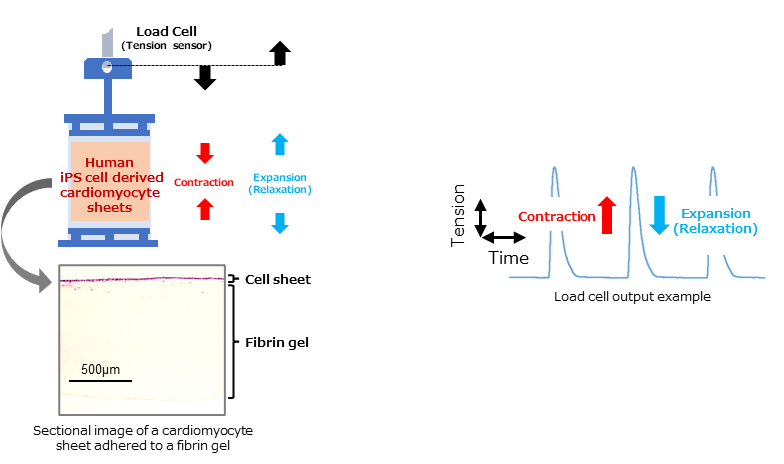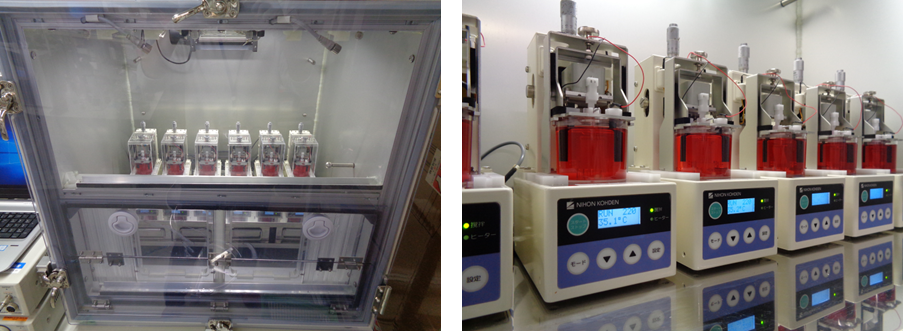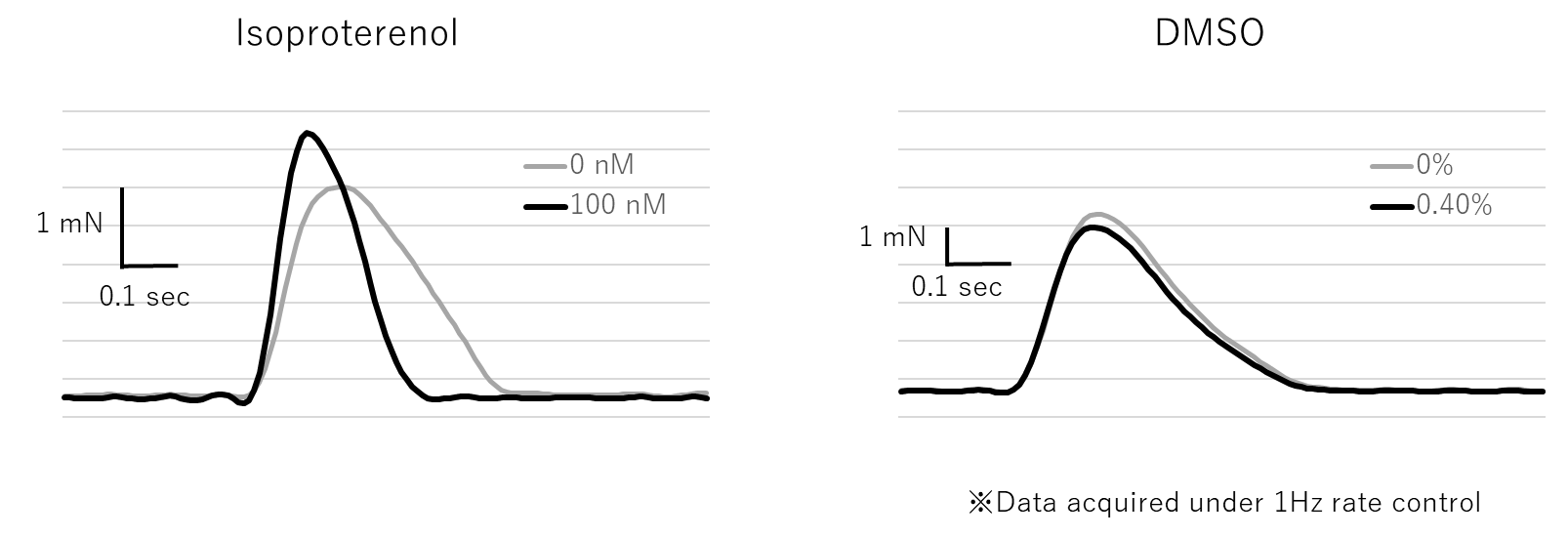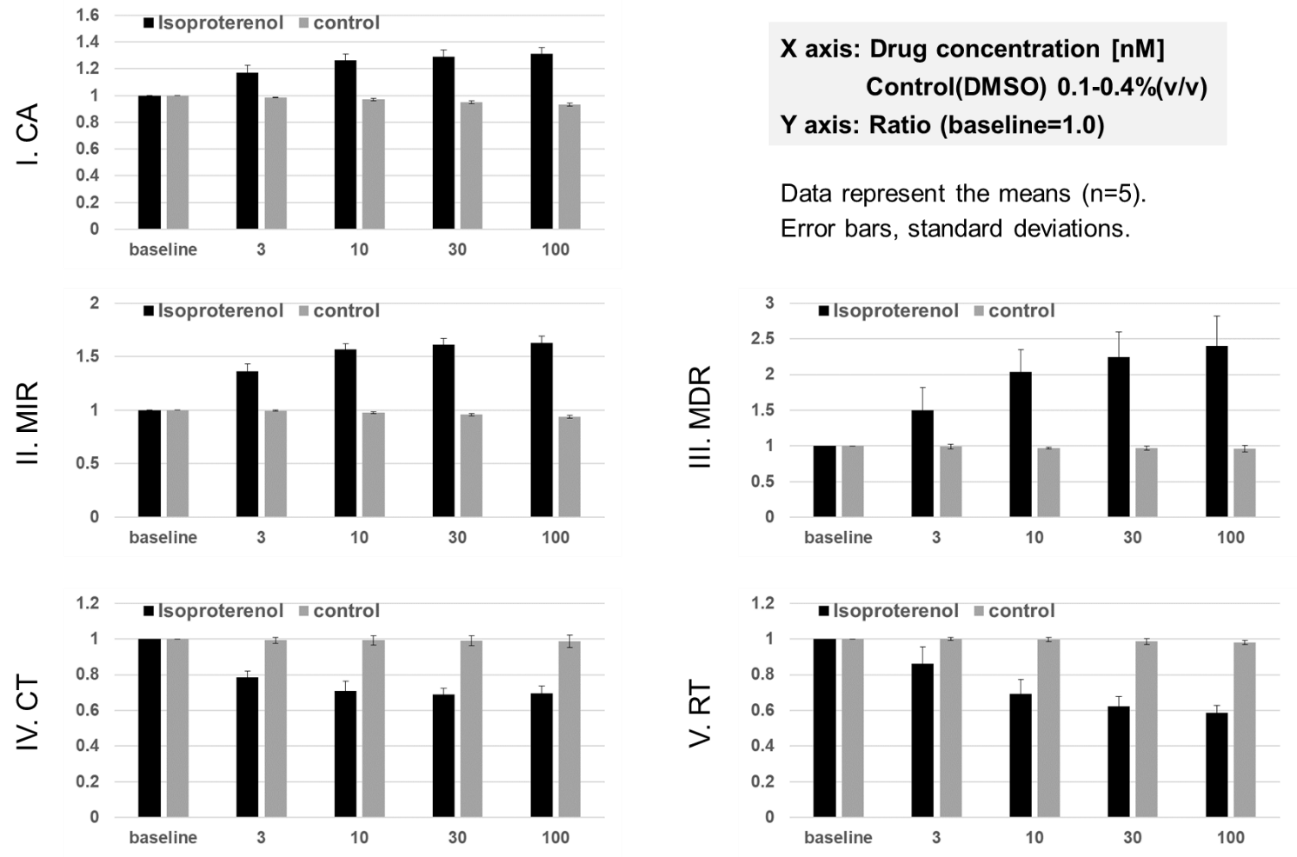Cardiac contractility evaluation service using human iPS cell-derived cardiomyocyte sheet tissue
Contents
・Overview of this service
・The significance of assessing cardiac contractility
・Method of evaluating cardiac contractility
・Example: Analysis of the effect of the positive inotropic agent isoproterenol on cardiac contractility
・How to use the service
・Publications
Overview of this service [back]
This service evaluates the potential cardiotoxicity of drug candidate compounds under development in vitro and features the following.
1. Using our cell sheet engineering technology (*1), we create beating heart-muscle tissue sheets using human iPS cell-derived cardiomyocytes (hiPSC-CMs).
2. Next, we directly measure the contractile force generated by the tissue, examine the effect of the drug candidate compounds on cardiac contractility (*2) and obtain data on the effect of the compounds in question on contractility.
3. The use of a highly sensitive tension measurement system and powerful data acquisition software (LabChart®) enables the acquisition of high-precision data on tension waveforms over a long period of time, as well as detailed post-analysis.
(*1) Cell sheet engineering technology
Cell sheet engineering is a technology developed by Professor Emeritus and Specially Appointed Professor Teruo Okano of Tokyo Women's Medical University that enables the collection of confluently cultured cells in the form of a sheet using a temperature-responsive culture dish [1]. It has been attracting attention as one of the fundamental technologies for the development of regenerative medicine.
(*2) Cardiac Contractility
Myocardial contractility is defined as "the inherent ability of cardiac muscle fibers to shorten" [2], and in clinical practice, left ventricular ejection fraction is used as a surrogate measure of cardiac contractility. Since both decreased and increased cardiac contractility can cause clinical problems, careful assessment of the effect of a drug on cardiac contractility is important for the safe use of the drug [2].
The significance of assessing cardiac contractility [back]
In the field of drug discovery, cardiotoxicity, along with hepatotoxicity and neurotoxicity, are known to be the most common toxicities that cause drug development to be discontinued. Therefore, it is worthwhile to investigate potentially cardiotoxic properties of a drug candidate compound under development prior to the initiation of clinical research, when development costs drastically increase.
1. Necessity of cardiac contractility assessment in the evaluation of cardiotoxicity of drug candidate compounds
Cardiac contractility is an independent parameter that is different from the information obtained from electrophysiological tests using patch clamps and/or multi-electrode array systems, and is listed as one of the follow-up studies in the guidelines for safety pharmacology studies [3]. For example, in an evaluation of itraconazole, an antifungal drug that causes congestive heart failure, an off-target inhibitory effect on cardiac contractility (negative inotropic effect) was observed [4], confirming the need for cardiac contractility assessment. Many similar drugs have been identified [5], suggesting the need for cardiotoxicity assessment with new indicators.
2. Necessity of cardiac contractility assessment in the development of pharmaceuticals (cancer drugs)
In recent years, the number of cases in which cancer drugs are administered over a long period of time has been increasing, and the number of deaths caused by diseases other than the primary cancer, especially cardiovascular diseases, has also been increasing [6]. Therefore, there is a need to properly evaluate the effects of long-term administration of cancer drugs on the heart. It is also important to investigate in detail the effects of cancer drugs under development on cardiac contractility of cardiomyocytes in preclinical studies.
Method of evaluating cardiac contractility [back]
A cardiomyocyte sheet is adhered to a fibrin gel, and the tension generated when the cells contract and expand is directly measured with a load cell (highly sensitive tension sensor). The flow of the evaluation of the target compound is shown below.
STEP1: Preparation of cardiomyocyte sheet tissue
Human iPS cell-derived cardiomyocytes are cultured and harvested as cell sheets. By attaching these cell sheets on fibrin gel bases, we construct cardiomyocyte sheet tissues. The cell sheets can be multilayered according to the application. After additional tissue culture and pretreatments, the quality of these tissues is checked, and only those that pass are used for the following tension measurement.

STEP2: Tension measurement and compound dosing test
The cardiomyocyte sheet tissue is set in the culture chamber, and the tension generated when the cells contract and expand is measured directly with a load cell. The agitation and temperature of the culture medium are properly controlled, and the contraction of cardiomyocyte tissue can be paced by electrical stimulation where beating rate control is thought to be important for evaluating the effects of test compounds on contractility [7]. Tension can be measured continuously for up to 5 days. Test compounds are administered on an appropriate schedule to evaluate their effects on tension.

References
[1] Shimizu et al. (2003) Biomaterials 24:2309-2316
[2] Guth et al. (2019) Frontiers in Pharmacology 10:884
[3] ICH Harmonized Tripartite Guideline (S7A) “Safety Pharmacology Studies for Human Pharmaceuticals” (2000)
[4] Ahmad et al. (2001) Lancet 357:1766-1767
[5] Page et al. (2016) Circulation 134:e32-e69
[6] Sturgeon et al. (2019) European Heart Journal 40:3889-3897
[7] Hinata et al. (2022) Journal of Pharmacological and Toxicological Methods 118:107228
Example: Analysis of the effect of the positive inotropic agent isoproterenol on cardiac contractility [back]
The waveform of tension generated during contraction and expansion (relaxation) of cardiomyocytes changed as shown in the figure below after administration of the positive inotropic agent Isoproterenol. In other words, the wave height (peak height) became larger, and the time required for contraction and relaxation became shorter. In the case of the control (solvent (DMSO) only), the tension waveform was almost unchanged.

The tension waveform is characterized by the following five parameters I to V, and the effect of the administered compound on cardiomyocytes can be captured as changes in these parameters. In the case of isoproterenol, as shown in the figure below, each parameter changed in a concentration-dependent manner, and this result well reflects the effect of isoproterenol on the living heart.


For international (outside of Japan) customers [back]
Currently, we offer these services for Japanese customers only. We have a plan to offer them for international customers in near future. If you are interested in our services, please do not hesitate to contact us. Inquiries from international customers are welcome.
Publications: articles and presentations related to our technology [back]
Importance of beating rate control for the analysis of drug effects on contractility in human induced pluripotent stem cell-derived cardiomyocytes,
Yuto Hinata, Yuki Kagawa, Hirotsugu Kubo, Eriko Kato, Atsushi Baba, Daisuke Sasaki, Katsuhisa Matsuura, Kohei Sawada, Tatsuya Shimizu,
Journal of Pharmacological and Toxicological Methods, 118:107228 (2022)
Analysis of force vector field during centrifugation for optimizing cell sheet adhesion,
Yuji Haraguchi, Yuki Kagawa, Hirotsugu Kubo and Tatsuya Shimizu,
Biotechnology Progress, 35:e2857 (2019)
Rapid creation system of morphologically and functionally communicative three-dimensional cell-dense tissue by centrifugation,
Yuji Haraguchi, Katsuhisa Matsuura, Yuki Kagawa, Akiyuki Hasegawa, Hirotsugu Kubo and Tatsuya Shimizu,
Biotechnology Progress, 34:1447-1453 (2018)
Contractile force measurement of human induced pluripotent stem cell-derived cardiac cell sheet-tissue,
Daisuke Sasaki, Katsuhisa Matsuura, Hiroyoshi Seta, Yuji Haraguchi, Teruo Okano, Tatsuya Shimizu,
PLOS ONE 13(5): e0198026 (2018)
https://doi.org/10.1371/journal.pone.0198026
